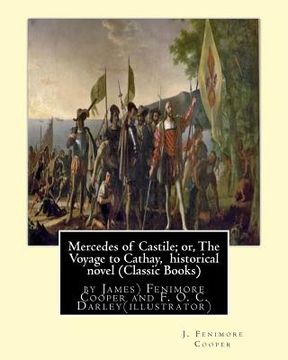Mercedes of Castile; or, The Voyage to Cathay, historical novel (Classic Books): by J.(James) Fenimore Cooper and F. O. C. Darley, Felix Octavius Carr (en Inglés)
Reseña del libro "Mercedes of Castile; or, The Voyage to Cathay, historical novel (Classic Books): by J.(James) Fenimore Cooper and F. O. C. Darley, Felix Octavius Carr (en Inglés)"
Mercedes of Castile; or, The Voyage to Cathay is a 1840 historical novel by James Fenimore Cooper. The novel is set in 15th century Europe, and follows the preparations and expedition of Christopher Columbus westward to the new world, Archival materials A full manuscript of the novel is held at the The Clifton Waller Barrett Library of American Literature in the Albert and Shirley Small Special Collections Library at the University of Virginia.Contemporary reception The New York Review of Books reviewed the novel in 1840 and was unimpressed, saying the novel was not contributing to "any great increase of fame or fortune to Mr Cooper".The review continued to describe the novel as not including much "romance", instead successfully focusing on the historical elements.In 1978, critic Kennedy Williams, Jr. agreed with the assessment, noting that the novel uses history well and accurately, but is Cooper's best example of the combination of history and fiction when "fail[ing] miserably" in Cooper's novels. James Fenimore Cooper (September 15, 1789 - September 15, 1851) was a prolific and popular American writer of the early 19th century.His historical romances of frontier and Indian life in the early American days created a unique form of American literature. He lived most of his life in Cooperstown, New York, which was founded by his father William on property that he owned. Cooper was a lifelong member of the Episcopal Church and, in his later years, contributed generously to it.[1] He attended Yale University for three years, where he was a member of the Linonian Society, but was expelled for misbehavior. Before embarking on his career as a writer, he served in the U.S. Navy as a Midshipman, which greatly influenced many of his novels and other writings. The novel that launched his career was The Spy, a tale about counterespionage set during the Revolutionary War and published in 1821.He also wrote numerous sea stories, and his best-known works are five historical novels of the frontier period known as the Leatherstocking Tales. Among naval historians, Cooper's works on the early U.S. Navy have been well received, but they were sometimes criticized by his contemporaries. Among his most famous works is the Romantic novel The Last of the Mohicans, often regarded as his masterpiece.James Fenimore Cooper was born in Burlington, New Jersey in 1789 to William Cooper and Elizabeth (Fenimore) Cooper, the eleventh of 12 children, most of whom died during infancy or childhood. He was descended from James Cooper of Stratford-upon-Avon, Warwickshire, England, who emigrated to the American colonies in 1679. James and his wife were Quakers who purchased plots of land in New Jersey and Pennsylvania. Seventy-five years after his arrival in America, his great-grandson William was born on December 2, 1754. Shortly after James' first birthday, his family moved to Cooperstown, New York, a community founded by his father on a large piece of land which he had bought for development. Later, his father was elected as a United States Congressman from Otsego County. Their town was in a central area of New York that had previously been occupied by the Iroquois of the Six Nations. The Iroquois were forced to cede their territory after British defeat in the Revolutionary War, as they had been allies.Shortly after the American Revolutionary War, the state opened up these former Iroquois lands for sale and development. Cooper's father purchased several thousand acres of land in upstate New York along the head-waters of the Susquehanna River. By 1788, William Cooper had selected and surveyed the site where Cooperstown would be established. He erected a home on the shore of Otsego lake and moved his family there in the autumn of 1790. He soon began construction of the mansion that would be known as Otsego Hall. It was completed in 1799 when James was ten.

